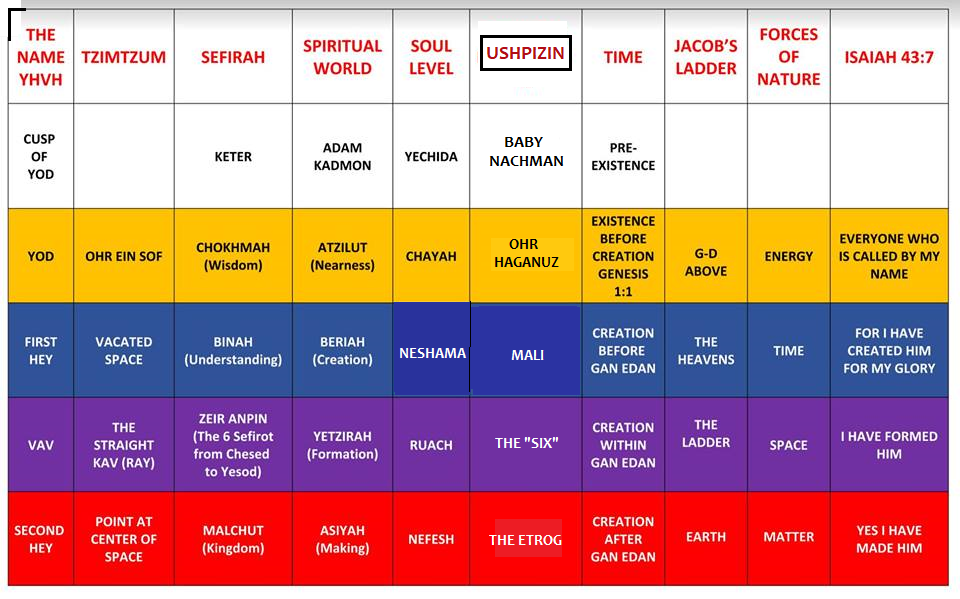 There are two major concepts that provide ‘templates’ for understanding reality according to Torah. One is the ten Sefirot, the ten “G-dly emanations” that extend into creation. We have shown how these relate closely to the characters and elements of the movie.
There are two major concepts that provide ‘templates’ for understanding reality according to Torah. One is the ten Sefirot, the ten “G-dly emanations” that extend into creation. We have shown how these relate closely to the characters and elements of the movie.
The other is called the “Worlds of existence.” These are not ‘worlds’ in terms of planets, but ‘levels’ of spiritual reality, from that which includes our own physical existence to the world of angels, and that of the world of the heavenly throne room, and beyond.
These two ‘templates’ relate to each other in that the Sefirot are the “building blocks” of each world of existence, though ‘functioning’ differently. This impacts the very language we use regarding them. Not only do the terms used in Torah literature have different meanings than they do in everyday English parlance, but the meaning within Torah discussion also varies depending on what ‘world’ is being discussed. This includes even simple English words like; “name, wisdom, space, nearness, love,” etc.
The chart at the bottom features selections from the 13 Petals SOUL CHART along with a column showing several elements of the Ushpizin movie. The basic idea is that all of reality is structured around a framework of five “levels” or “worlds.”
These worlds closely relate to the “most holy Name of G-d,” which is made of the letters Yod, Hey, Vav, He (YHVH). The fifth world comes via the first letter, Yod, which has the hidden ‘5th’ level in it, in terms of the ‘cusp’ of the Yod, at its top. This is the dot made when you put your pen down, which ‘vanishes’ once you complete the drawing of the letter.
The worlds are, from the “top-down,” known as:
- Adam Kadmon (“original man” – complete unity – ‘unknowable’ to us in our present existence)
- Atzilut (nearness – existence before creation – reflected in the first few words of Genesis 1:1 – see below)
- Beriah (creation – the spiritual heavens/shamayim with the heavenly throne/temple and archangels/forces/powers)
- Yetzirah (formation – the angelic world within creation)
- Asiyah (making – our world of physicality, time and space, also within creation)
Some things present, or present more clearly, at all five levels and some less. Another helpful insight is the lower three worlds (bottom three rows on the chart in red, purple, blue) relate to the worlds, “within creation.” The row in gold is “within existence but pre-creation,” and the top row is considered “pre-existence.” The “color-coding” of the rows is intentional and found in Torah.
Note where the chart states, “existence before creation Genesis 1:1,” would more accurately be stated, prior to the word “created” (bara) in that verse. The words, “In the beginning, Elohim …”, relate to the pre-creation world of Atzilut. Once we come to the word “created/bara,” we are entering the world of Beriah (from ‘bara’), the beginning of Creation.
We will look a bit more at these worlds with relation to the movie, “from the bottom up.”
Ushpizin Movie Elements and the “Worlds” of Existence
Asiyah
The etrog relates to the lowest world (Asiyah, that of our physical existence) and Sefirah of Malchut (kingdom) as well as the Shekinah in our world as well as, “Jerusalem below.” The “blessing” (bracha) for having a son lies “hidden” in the etrog. The implication here is that something may be required of us in this world, to attain or release this. This often relates to the concept of tzimtzum, where superfluous things or preconceived ideas must be ‘constricted’ for the connection to be initiated.
“On the most basic level, a bracha is a means of recognizing the good that God has given to us. As the Talmud2 states, the entire world belongs to God, Who created everything, and partaking in His creation without consent would be tantamount to stealing. When we acknowledge that our food comes from God – i.e. we say a bracha – God grants us permission to partake in the world’s pleasures. This fulfills the purpose of existence: To recognize God and come close to Him. Once we have been satiated, we again bless God, expressing our appreciation for what He has given us. So, first and foremost, a bracha is a “please” and a “thank you” to the Creator for the sustenance and pleasure He has bestowed upon us.”
From “What is a Bracha?” at https://www.aish.com/jl/jewish-law/blessings/1-What-is-a-Bracha.html
Yetzirah
The world of Yetzirah is associated with the path between the world below (Asiyah) and that above (Beriah). Thus, it is related to the letter vav (a connecting hook), Jacob’s ladder in his dream (Genesis 28), the Kav in creation (see row 2 in chart below) and the six middot we need to work on (Tikkun Middot) as the vav is the sixth letter in the aleph-bet.
Yetzirah is the world in constant flux and change (the world of angels) and levels of connectivity between the letter Hey below and Hey above. Thus it is associated with the six main masculine characters in the movie. (The letters in YHVH are seen as the Yod and Vav being ‘masculine’ and the two Heys as ‘feminine’ – relating to the male and female aspects of the Image of G-d in Genesis 1:27.
This is the path of teshuvah, which may be read “tashuv hey,” literally “returning the (lower) letter Hey.” As mentioned, this lower Hey is the etrog in the movie, which holds within it the key for the blessing of having a child. The upper Hey is Mali, seeking to have a child. See https://www.chabad.org/library/article_cdo/aid/361890/jewish/Teshuvah.htm
Beriah
The “uppermost” world within the three worlds of Creation, Beriah (associated with ‘bara/created’ in verse 1), is very ‘conceptual.’ (Examine the middle column (letter Hey, Neshama, etc) of the 13Petals Soul Chart.) This is also the world that the Sefirah of Binah (Understanding) is primarily associated with. One aspect of this is “Jerusalem above,” that is also called the upper Shekinah or mother. The six Sefirot of Yetzirah and Malchut below them, are the ‘7 pillars’ of ‘her’ (Binah) house mentioned here:
“Wisdom has built her house, She has hewn out her seven pillars.”
Proverbs 9:1
In the movie, Mali (the soon to be ‘mother’) is associated with Binah/Beriah. She is “on the other side of the six” from the etrog. The connection between the two, turning the etrog’s blessing into the reality of her having a child, depends on rectification of those six. As such Binah itself is also called “Teshuvah,” as the restoration of the lower Sefirot enables the “return of the lower Hey to the upper Hey. (Also considered unity the lower and upper Shekinah and lower and upper Jerusalem.)
Atzilut
This is the world “outside of creation” but “within existence.” We can somewhat relate to this, not as clearly as that existing within the measurable confines of Creation, but also not hidden beyond our capacity like the hidden cusp of the Yod. Thus the definition, “nearness,” means “near” to that which is outside our scope.
As mentioned, the first few words of the Torah, just before ‘bara,” apply to this level of existence. This is why the Torah starts with the letter Beit, the second of the Hebrew Aleph-Beit (alphabet). As startling as it sounds, it hints to us that there is something even before “Elohim” as the idea of G-d as ‘creator’ is something we can still understand to a degree. (See the short video, “In the Beginning, G-d Was Created!” by Daniel Matt.)
In the movie, this world is associated with the Ohr Haganuz, the “hidden light,” which is both the name of Moshe Ballanga’s yeshivah, as well as what he shouts about when he becomes intoxicated in the Sukkah with his two guests. (Interestingly, what he says is quite accurate, despite his state.)
This world is also associated with the idea of G-d as Abba/Father. When we related to G-d “within our existence in creation,” this is the idea of “Our Father in Heaven,” where ‘heaven’ is Beriah, the uppermost world within creation, where the “throne room of G-d exists.”
This “light” is similar to the idea of “Ohr Ein Sof,” the light of Ein Sof (= “without end,” a way of referencing G-d at the unknowable fifth world above and beyond, as ‘eternal’ cannot be encapsulated in any way.) Whereas Ohr Ein Sof applies to that light in general, Ohr Haganuz is the idea of (part of) this light being ‘hidden away’ for the righteous until the Olam Haba (the world to come), though it is possible to ‘access’ it in this life, primarily through Torah study, and also meditation and mitzvoth (Re: Deuteronomy 6:5).
As seen in the chart, this level is ‘between that’ of Creation and the “5th world” above – where Baby Nachman is ‘hidden’ (like the cusp in the Yod). He will come into existence (and creation) when all the necessary tikkunim (repairs) and connections are made according to Hashgaha Pratit – “specific Divine providence.”
Adam Kadmon
It is beyond the scope of this or any study to try to delve into understanding things pertaining to this level, for the simple reason as there is not much known and thus little written about it with any specificity. Even the term “world” is generally used only with the lower four worlds already mentioned. “Adam Kadmon” (lit: “original man” – even older is “Adam haKadmoni”) is but one term we apply to this level, which is associated with (but not confining) G-d as the singular, infinite, “Ein Sof.”
One way to try to understand this, is that existence (as we can know it Torah-wise) is ‘bookended” between Genesis 1:1 and the end of the 1000-year messianic kingdom to come. Anything before the former and after the latter is considered “out of bounds” for us.
“All the prophets prophesied only for the days of the Messiah, but as for the world to come, ‘Eye hath not seen, oh G-d, beside Thee.'”
Talmud, Berachoth 34b
There is a also a tradional teaching that when Moses was shown the “back” of G-d, it pertained to those things “within these bookends,” whereas the “face” that he was not allowed to see, was beyond those boundaries.
“From the rear and the front You encompassed me, and You placed Your pressure upon me.”
Psalm 139:5
Have fun perusing the chart. We will expand on this in the section on Templates.

